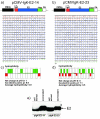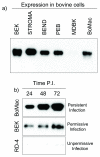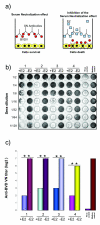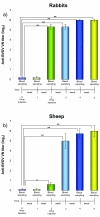Establishment of a bovine herpesvirus 4 based vector expressing a secreted form of the bovine viral diarrhoea virus structural glycoprotein E2 for immunization purposes
- PMID: 17945009
- PMCID: PMC2048506
- DOI: 10.1186/1472-6750-7-68
Establishment of a bovine herpesvirus 4 based vector expressing a secreted form of the bovine viral diarrhoea virus structural glycoprotein E2 for immunization purposes
Abstract
Background: The biological characteristics of BoHV-4 make it a good candidate as a gene delivery vector for vaccination purposes. These characteristics include little or no pathogenicity, unlikely oncogenicity, the capability to accommodate large amounts of foreign genetic material, the ability to infect several cell types from different animal species, and the ability to maintain transgene expression in both undifferentiated and differentiated cells.
Results: A recombinant bovine herpesvirus 4 (BoHV-4CMV-IgKE2-14 Delta TK) expressing an enhanced secreted form of the bovine viral diarrhea virus (BVDV) structural glycoprotein E2 (gE2-14), obtained by the removal of the putative transmembrane domain and addition of a 14 amino acids peptide at its carboxyl terminal and an immunoglobulin K signal peptide to the amino terminal, was successfully constructed using a Recombineering (recombination -mediated genetic engineering) approach on BoHV-4 cloned as bacterial artificial chromosome. The galactokinase - based recombineering system was modified by the introduction of a kanamycin expression cassette and a kanamycin selection step that allowed a significant reduction of the untargeted background clones. BoHV-4CMV-IgKE2-14 Delta TK infected cell lines highly expressed gE2-14, which maintained native antigenic properties in a serum neutralization inhibition test. When rabbits and sheep were immunized with BoHV-4CMV-IgKE2-14 Delta TK, high levels of serum neutralized antibodies against BVDV were generated.
Conclusion: This work highlights the engineerization of BoHV-4 genome as a vector for vaccine purposes and may provide the basis for BVDV vaccination exploiting the BoHV-4- based vector that delivers an improved secreted version of the BVDV structural glycoprotein E2.
Figures





Similar articles
-
A recombinant bovine herpesvirus-4 vectored vaccine delivered via intranasal nebulization elicits viral neutralizing antibody titers in cattle.PLoS One. 2019 Apr 19;14(4):e0215605. doi: 10.1371/journal.pone.0215605. eCollection 2019. PLoS One. 2019. PMID: 31002724 Free PMC article.
-
Recombinant bovine herpesvirus 4 (BoHV-4) expressing glycoprotein D of BoHV-1 is immunogenic and elicits serum-neutralizing antibodies against BoHV-1 in a rabbit model.Clin Vaccine Immunol. 2006 Nov;13(11):1246-54. doi: 10.1128/CVI.00200-06. Epub 2006 Aug 23. Clin Vaccine Immunol. 2006. PMID: 16928886 Free PMC article.
-
Double immunization strategy with a BoHV-4-vectorialized secreted chimeric peptide BVDV-E2/BoHV-1-gD.Vaccine. 2008 Nov 11;26(48):6031-42. doi: 10.1016/j.vaccine.2008.09.023. Epub 2008 Sep 21. Vaccine. 2008. PMID: 18812200
-
Cellular targeting of engineered heterologous antigens is a determinant factor for bovine herpesvirus 4-based vaccine vector development.Clin Vaccine Immunol. 2009 Nov;16(11):1675-86. doi: 10.1128/CVI.00224-09. Epub 2009 Sep 30. Clin Vaccine Immunol. 2009. PMID: 19793901 Free PMC article.
-
Assessment of bovine herpesvirus 4 based vector in chicken.J Virol Methods. 2008 Mar;148(1-2):303-6. doi: 10.1016/j.jviromet.2007.12.006. J Virol Methods. 2008. PMID: 18243344
Cited by
-
A recombinant bovine herpesvirus-4 vectored vaccine delivered via intranasal nebulization elicits viral neutralizing antibody titers in cattle.PLoS One. 2019 Apr 19;14(4):e0215605. doi: 10.1371/journal.pone.0215605. eCollection 2019. PLoS One. 2019. PMID: 31002724 Free PMC article.
-
Bovine Herpesvirus-4-Vectored Delivery of Nipah Virus Glycoproteins Enhances T Cell Immunogenicity in Pigs.Vaccines (Basel). 2020 Mar 2;8(1):115. doi: 10.3390/vaccines8010115. Vaccines (Basel). 2020. PMID: 32131403 Free PMC article.
-
Bovine Herpesvirus-4 Based Vaccine Provides Protective Immunity against Streptococcus suis Disease in a Rabbit Model.Vaccines (Basel). 2023 May 20;11(5):1004. doi: 10.3390/vaccines11051004. Vaccines (Basel). 2023. PMID: 37243109 Free PMC article.
-
Induction of Antihuman C-C Chemokine Receptor Type 5 Antibodies by a Bovine Herpesvirus Type-4 Based Vector.Front Immunol. 2017 Oct 25;8:1402. doi: 10.3389/fimmu.2017.01402. eCollection 2017. Front Immunol. 2017. PMID: 29118763 Free PMC article.
-
Bovine herpesvirus 4-based vector delivering the full length xCT DNA efficiently protects mice from mammary cancer metastases by targeting cancer stem cells.Oncoimmunology. 2018 Sep 6;7(12):e1494108. doi: 10.1080/2162402X.2018.1494108. eCollection 2018. Oncoimmunology. 2018. PMID: 30524888 Free PMC article.
References
-
- Storz J, Ehlers B, Todd WJ, Ludwig H. Bovine Cytomegaloviruses: Identification and Differential Properties. J Gen Virol. 1984;65:697–706. - PubMed
-
- Bartha A, Juhasz M, Liebermann H. Isolation of a bovine herpesvirus from calves with respiratory disease and keratoconjunctivitis. A preliminary report. Acta Vet Acad Sci Hung. 1966;16:357–358. - PubMed
-
- Ludwig H. Bovine herpersviruses. In: Roizman B, editor. The herpesviruses. Vol. 2. New York, N.Y., Plenum Press; 1983. pp. 135–214.
Publication types
MeSH terms
Substances
LinkOut - more resources
Full Text Sources
Other Literature Sources
Medical

